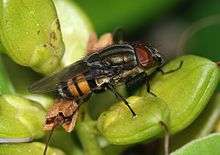Stomorhina lunata
| Stomorhina lunata | |
|---|---|
 | |
| Male Stomorhina lunata | |
| Scientific classification | |
| Kingdom: | Animalia |
| Phylum: | Arthropoda |
| Class: | Insecta |
| Order: | Diptera |
| Family: | Calliphoridae |
| Subfamily: | Rhiniinae |
| Genus: | Stomorhina |
| Species: | S. lunata |
| Binomial name | |
| Stomorhina lunata | |
| Synonyms | |
|
Stomorhina selgae Lehrer, 1979[2] | |
Stomorhina lunata is a species of fly in the family Calliphoridae.[3]
Distribution and habitat
This species is present in most of Europe, in the Afro-tropical ecozone, in the eastern Palearctic ecozone, in the Near East, in the Nearctic ecozone, in North Africa and in the Oriental ecozone.[4] These flies usually inhbit meadows.
Description
Stomorhina lunata can reach a length of 5–9 millimetres (0.20–0.35 in) and a wingspan of 13–16 millimetres (0.51–0.63 in).[5] These distinctive, medium-sized blowflies are rather similar to the house flies, but they have a characteristic prominent proboscis, a longitudinally striped thorax and an abdomen with yellow and black bands. Males have large orange patches on the sides of tergites 3 and 4, while females only show grey dust patches.[6]
This distinctively marked species is often misidentified because of the unusual band pattern in the abdomen, typical of hoverflies.
Biology
S. lunata is an important egg predator of some major African agricultural pests, the South African Brown locust (Locustana pardalina), the more widespread Desert locust (Schistocerca gregaria), and the migratory locust (Locustana migratoria).[6][7][8]
Adults are migratory and are present from July to October. They can usually be found feeding on nectar and pollen of umbellifer flowers (Apiaceae) and of Asteraceae species (mainly Scorzoneroides autumnalis, Tanacetum vulgare, Anthriscus sylvestris, Erysimum cheiranthoides, Filipendula ulmaria).[5][6]
References
| Wikispecies has information related to Stomorhina lunata |
| Wikimedia Commons has media related to Stomorhina lunata. |
- ↑ "Stomorhina". Integrated Taxonomic Information System.
- ↑ D. Gonzalez Mora & S. V. Peris (1988). "Los Calliphoridae de España, I: Rhiniinae y Chrysomyinae (Diptera)". Eos Madrid. 64 (1): 91–139.
- ↑ Catalogue of life
- ↑ Fauna europea
- 1 2 J.K. Lindsey Commanster
- 1 2 3 Greathead, D. J.; C. Kooyman; M. H. Launois-Luong; G. B. Popov (1994). "Les ennemis naturels des criquets du Sahel" (pdf). Ministère des Affaires Étrangères des Pays-Bas et CIRAD/PRIFAS (France). Retrieved 2008-04-03.
- ↑ Popov, G. B.; M. H. Launois-Luong; J. van der Weel (1990). "Les oothèques des criquets du Sahel" (pdf). Ministère des Affaires Étrangères des Pays-Bas et CIRAD/PRIFAS (France). Retrieved 2008-04-03.
- ↑ Griffiths, Charles; Mike Picker; Alan Weaving (2005-06-30). Field Guide To Insects Of Southern Africa. South Africa: Struik Publishers. p. 440. ISBN 978-1-77007-061-5.
External links